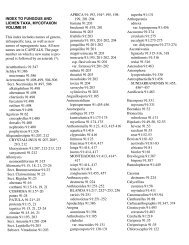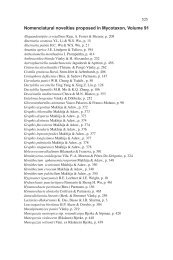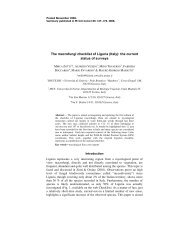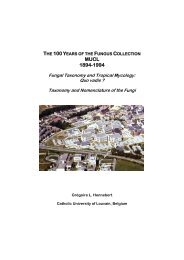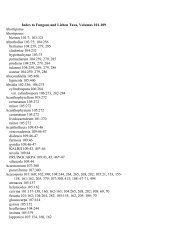download full review [pdf] - Mycotaxon
download full review [pdf] - Mycotaxon
download full review [pdf] - Mycotaxon
You also want an ePaper? Increase the reach of your titles
YUMPU automatically turns print PDFs into web optimized ePapers that Google loves.
<strong>Mycotaxon</strong> 110 Book Reviews ... 523<br />
and convincing. Each taxon is illustrated by a range of specimens shown life-size<br />
or larger and often taken from two or more collections. Agaricus subperonatus,<br />
for example, is illustrated by 14 specimens from four collections, enabling<br />
the author to show variations in colour, size, and form; Entoloma cetratum is<br />
illustrated by more than 30 specimens from eight collections. All are clearly<br />
cross-referenced to collection data in the text volume. Most of the watercolours<br />
are painted from life – the result of extensive foraying going back at least 30<br />
years. Some, however, are based on original or published photographs.<br />
Surprisingly, no fewer than 33 new taxa (species, varieties, and forms) are<br />
described in the text, with additional taxa (some as yet unnamed) provisionally<br />
described. The author notes that several specialists, including A. Hausknecht<br />
and M. E. Noordeloos, have been consulted – indeed some of the new Entoloma<br />
taxa are jointly described with the latter author – but this still seems an awful<br />
lot of novelties for a non-molecular study in a mycobiota that is comparatively<br />
well-known. It might have been better to have published the new taxa in a peer<strong>review</strong>ed<br />
journal, particularly since the cost of these two volumes may put them<br />
beyond the reach of many individual mycologists.<br />
Despite (or perhaps because of) the high price tag, these are handsome<br />
volumes, extremely well illustrated, and thoroughly documented. If you can<br />
afford them, buy them. They will certainly bring you a great deal of pleasure.<br />
Peter Roberts<br />
Lower Penylan, Glasbury, Powys HR3 5NT, UK<br />
Annotated list of polypores for the Iberian Peninsula and Balearic Islands. By<br />
I. Melo, J. Cardoso & M.T. Telleria. 2007. J. Cramer in der Gebrüder Borntraeger<br />
Verlagsbuchhandlung, D-14129 Berlin, Germany . Pp. 183,<br />
figs 1. [Bibliotheca Mycologica no. 203.] ISBN 978-3-443-59105-2. Price 54 €.<br />
This checklist embraces the names of all polypores reported from the region, but<br />
is far more than a naked list. For each species, which are listed alphabetically,<br />
information is given on places of publication of the names and synonyms,<br />
the types, distribution down to the level of provinces, substrata (with tree<br />
species named), and collections in the region holding material of the taxon.<br />
There is also a substantial 44 pages of “bibliography surveyed” in compiling<br />
the checklist in addition to eight of works cited, and a comprehensive index<br />
by epithet. Sadly, the work is marred for me by a failure to understand the<br />
bibliographic references and dates to be accorded to sanctioned fungal names.<br />
For example, “Polyporus ulmarius Sowerby: Fr.” only has the reference to the<br />
place of sanctioning, which is indicated as the basionym [!], and not to Sowerby’s<br />
original publication, where the true basionym is to be found. Also, the use of<br />
“in” in author citations does not follow the recent Codes. These may seem small<br />
points, but it is a reality that errors in standard checklists become perpetuated


![download full review [pdf] - Mycotaxon](https://img.yumpu.com/5381692/15/500x640/download-full-review-pdf-mycotaxon.jpg)
